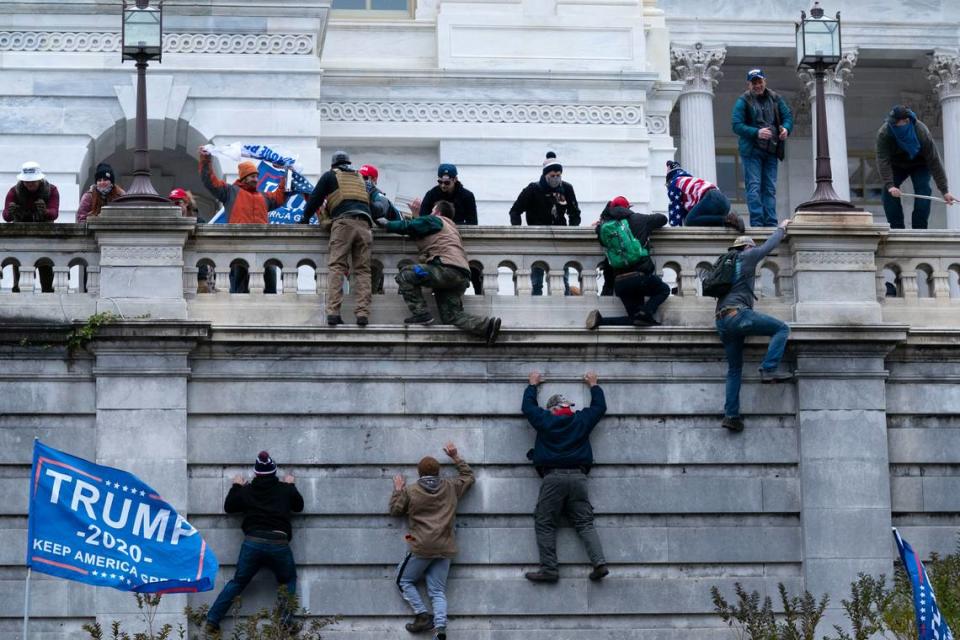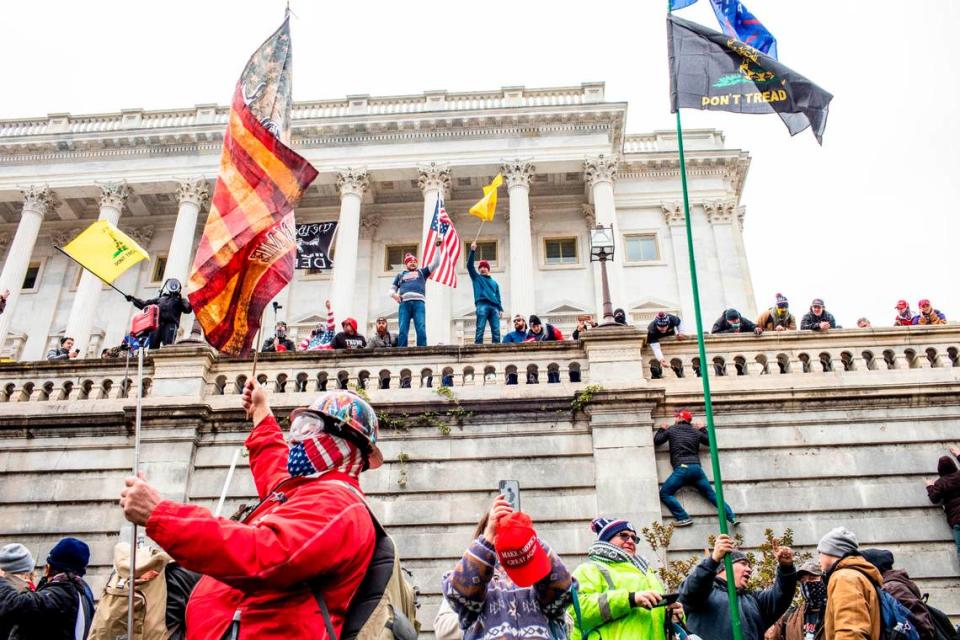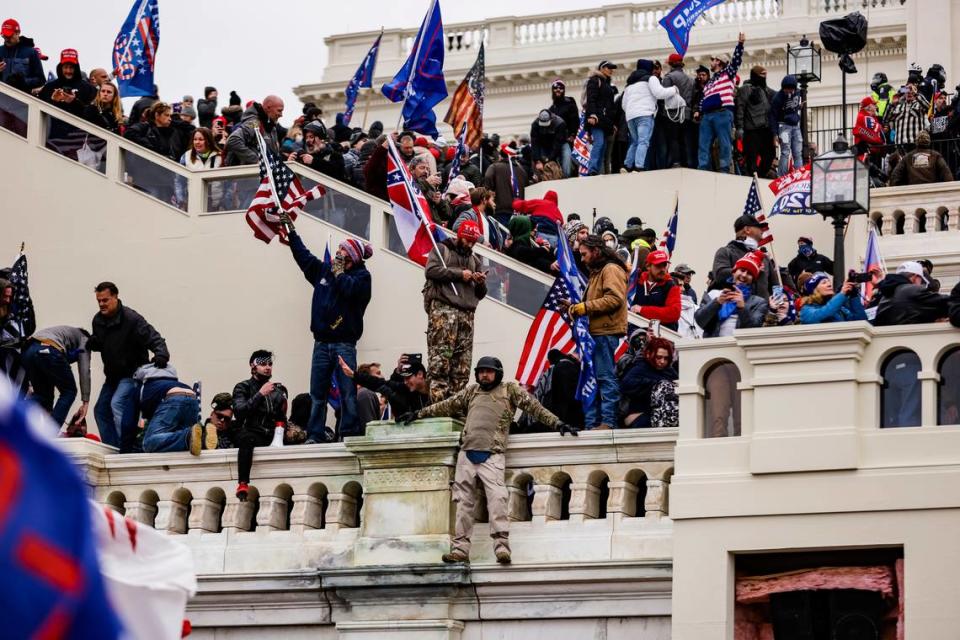What if those who stormed the Capitol had been Black? Here’s what some in Charlotte say.
Alvin Jacobs can speak from personal experience about protesting at the U.S. Capitol.
It was Sept. 20, 2016 — Jacobs remembers exactly because that’s also the night Keith Lamont Scott, a Black man, was fatally shot by a Charlotte police officer — and he was with about 10 other people outside of Paul Ryan’s office on the Hill, hoping to confront the then-House speaker to protest his stance on an immigration issue.
Ryan wasn’t around, Jacobs recalls. But law enforcement was.
“Let me tell you about the police presence there,” said Jacobs, a Black photographer and activist who lives in Charlotte and has spent years documenting protests around the country. “It’s different. The police are different. You don’t get to move an inch in that building without feeling like your life is in danger.”
On Wednesday afternoon, he saw scenes unfolding through social media and TV coverage inside the same building that begged for a law-enforcement response, yet seemed to largely go on without intervention.
Jacobs also saw what many Americans — particularly Black Americans — saw Wednesday afternoon on their televisions and computer and mobile screens, as a thousand or more supporters of President Donald Trump, mostly white, stormed the hallowed halls of the Capitol: a disheartening (though not-surprising, many felt) double standard.
From where Jacobs sits, it’s a stark contrast.

The rioters in Washington, he said, “were taking selfies and were able to leave, and then they did exit interviews (with the media) — because they don’t fear the police, don’t fear government agencies.” Black people who show up to protest? “We have to fear for our lives.”
It’s an opinion that was being loudly expressed over and over again on social media as it became increasingly obvious that most of those who had breached the Capitol were going to be allowed to have their way with the building, while police had handled Black Lives Matter protesters with a much heavier hand.
And it’s an opinion shared even by the man who will be sworn in as the United States’ 46th president in less than two weeks.
“We all know that’s true, and it’s unacceptable. Totally unacceptable,” President-elect Joe Biden said Thursday afternoon, noting that he’d also received a text from his granddaughter explaining how she thought the rules were being applied differently for the two different groups.
“The American people saw it,” he said, “in plain view.”
‘They would have been shooting’
Four people died during Wednesday’s riots in Washington, three of them of “medical emergencies” and one of them — Ashli Babbitt of San Diego, California — after being shot by a U.S. Capitol Police officer, according to news reports.
U.S. Rep. Alma Adams, a Charlotte Democrat, believes there would have been a lot more bloodshed if those involved in the rioting had been Black.
“They wouldn’t have just let people through,” she told a reporter on Thursday in Washington. “They would have been shooting people for that. I mean, look at all the Black folks that just get shot for doing nothing.”
Last year, Adams, who is Black, stood out as a vocal opponent of excessive use of force by Charlotte-Mecklenburg police in the wake of a controversial June incident in which police boxed a large group of peaceful protesters into a section of an uptown street and deployed tear gas on them. It was one of a series of protests that rolled through uptown Charlotte — and the entire country — in the wake of the killing of George Floyd by Minneapolis police last May 29.
Adams wound up introducing an amendment, adopted into an appropriations bill, to prohibit law enforcement from using federal funds to acquire chemical agents for domestic riot control.
“When you think about what happened in Charlotte, they were spraying people with all of this pepper spray,” Adams said. “They did some spraying yesterday, but they only sprayed once the people got (into the Capitol) — once they took over. So that was the problem. When we had peaceful protesters in Charlotte and they got (boxed in), I mean, they were peacefully protesting. They weren’t tearing anything down. Yet they pepper-sprayed them.”
For Charlotte, those are perhaps the most defining visual images, the videos that show Black Lives Matter protesters scattering into the night and desperately looking for a way out as their lungs filled with tear gas.
In Washington, by contrast, it’s possible that the images people won’t be able to get out of their heads are of satisfied-looking white men who are brazenly trespassing and looting.
Like the one of Adam Johnson, 36, of Parrish, Florida, the white man wearing the Trump ski hat who beamed and waved while walking through the Capitol with what appeared to be House Speaker Nancy Pelosi’s lectern cradled in his right arm.
Or the one of Richard Barnett, 60, of Gravette, Arkansas, the guy dressed in the flannel shirt who broke into Pelosi’s office and put his steel-toe-booted feet up on her desk. (The Washington Post reported that, last weekend, Barnett wrote this on Facebook, under a pseudonym: “I am white. There is no denying that. I am a nationalist. I put my nation first. So that makes me a white nationalist.”)
And it’s been hard for those who feel like there’s a double standard not to wonder — what if these men had been Black?

Robert Dawkins, political director for Charlotte-based Action N.C., a non-profit that does advocacy work for the poor, thinks it’s pretty clear:
“If a Black person had been sitting behind the Speaker of the House’s desk,” said Dawkins, who frequently travels to Washington for Black Lives Matter demonstrations and immigration advocacy, “they would be in jail right now and they would be facing probably sedition charges.”
Dawkins said he believes police would have been far, far more vigilant about keeping Black people outside of the Capitol if the racial roles were reversed.
“Anything that African Americans do to exercise our right is automatically assumed to be violent,” he said. “And anything white groups do, even if they are more militant, like walking around with a long rifle, is considered the First Amendment right to protest.”
Two different Americas
Similar sentiments were shared by other activists in Charlotte who have been around their share of protests and police.
“It was upsetting,” said Kass Ottley, another activist in Charlotte who either led or attended a number of the protests last summer. “I know that during several peaceful protests in Charlotte, we were met with heavy militarized police. At peaceful protests. In riot gear — in place, waiting for us. We were hit with tear gas, rubber bullets, bikes. And the fact they let them take the Capitol like that, it was unreal to me. It goes to show you that we’re living in two different Americas, one for white people with privilege and one for Black people.”
Braxton Winston, a Charlotte City Council member who first rose to political prominence after protesting Keith Scott’s killing, said advocates in Charlotte have been arrested and met with force for far less than the violence seen in Washington.
“The state is not organized to protect people,” he said. “It’s designed to protect white supremacy. And it will punish those that threaten white supremacy and whose goal it is to destroy it, and it will aid and abet those who desire to strengthen and perpetuate it.”
Winston, who is Black, was arrested this summer at a protest in Charlotte following the police killing of Floyd. He has said that he went in his official capacity to de-escalate tensions between police and citizens.
“I’m a threat to the system,” he said. “And if I intimidate agents of the state, regardless if it’s in a protest or it’s walking down the street, then my body, my existence — our existence — is threatening.”
Charlotte-Mecklenburg Police Chief Johnny Jennings said that after the riot yesterday, his first thought was about local impact.
“It’s always concerning when you see something like that anywhere in the nation, you want to see what that spillover is going to be in your community,” said Jennings, who is Black. “We feel very confident that at this point there is no indication that Charlotte is under any type of concern for having something similar but that could change any minute, at the drop of a hat. We just want to make sure that we stay prepared.”
Jacobs, the Charlotte photographer and activist, said that after witnessing the chaos Wednesday, he’s not sure what the outcome will be if a similar situation occurs in Charlotte.
“This is going to keep happening,” he said. “The implication is that when they (white men) group up they can do whatever they want, wherever they want. Charlotte is a banking city — if they want to hold the banks hostage or something like that, who’s going to stop them?”
People have plenty of questions about what happened on Wednesday in Washington.

Did law enforcement have a plan, and if so, what was it? If they didn’t, why not? For weeks, the president and his supporters have been hinting at the date. The Capitol Police, the agency responsible for protecting Congress, has more than 2,000 officers; were enough of them on the scene, and if so, how did things get so out of control? Could better planning and a larger police presence have kept the inside of the building from being breached? Should more people have been arrested, or more force applied?
It’s likely there will be arguments around such questions for a long time.
But Jacobs would love it if the most important lesson could be this one:
“We aren’t saying, ‘Why don’t you kill them like you kill us?’” he said. “We’re saying, ‘Treat us the way you treat them. Don’t arrest them like you arrest us and brutalize us, but treat us with respect and compassion — like how you treat them.’”
Brian Murphy contributed to this report from Washington, D.C.

